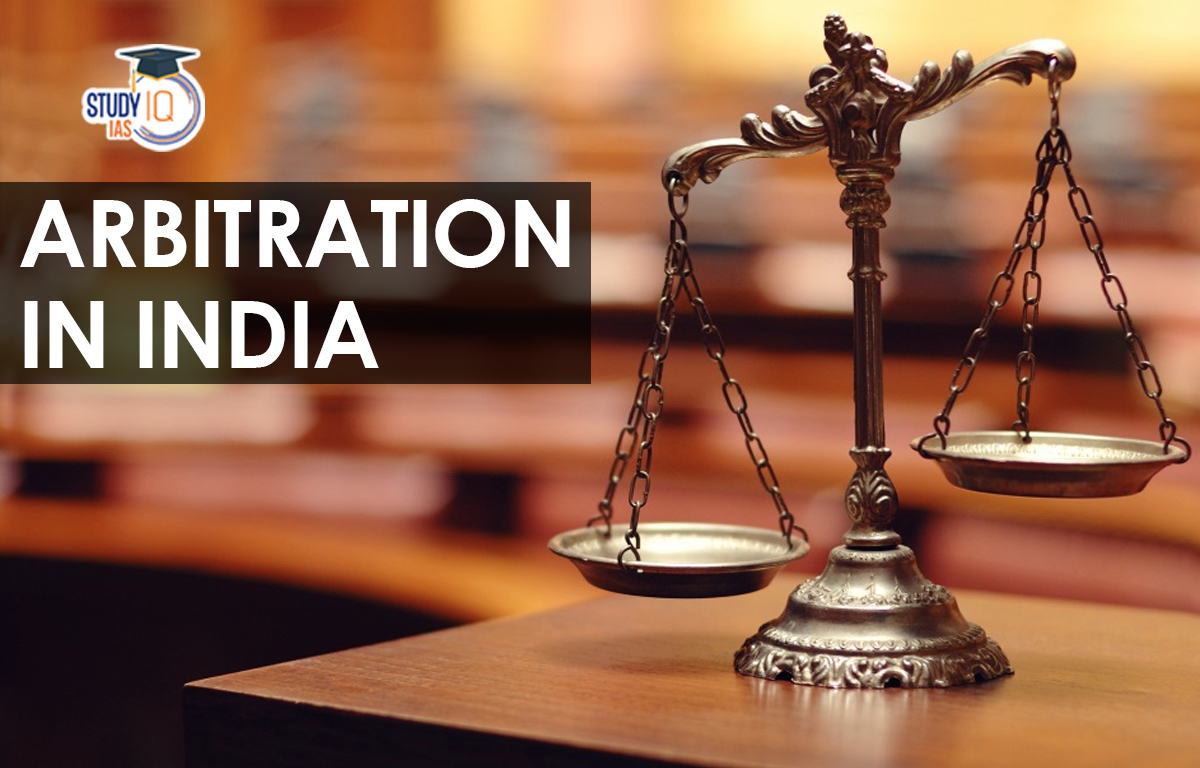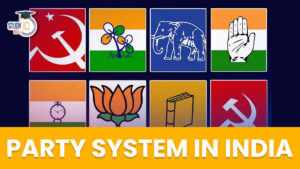Table of Contents
Context: India’s economic ascent has naturally sparked widespread discussions about the potential role of Indian arbitration in driving further growth.
What is Arbitration in India?
- Arbitration is a form of alternative dispute resolution (ADR) where parties to a dispute agree to resolve their differences outside of a court system.
- In arbitration,
- The parties in dispute agree to present their case to a neutral third party (called an arbitrator or a panel of arbitrators).
- The arbitrator hears the evidence and arguments from both sides.
- Based on this, the arbitrator makes a decision, which is usually final and binding on the parties.
- The Arbitration in India is governed and regulated by the Arbitration and Conciliation Act 1996 (which was amended in 2015, 2019 and 2021).
Benefits of Arbitration
- Minimises court intervention: Arbitration provides a more private and less formal setting for dispute resolution.
- Cost-effective: Litigating a dispute in court can be expensive, whereas arbitration can be a much more cost-effective option, as parties have more control over the process.
- Speed: There are well-defined time limits for passing awards, resulting in quick disposal of the matter.
- Fairness: Arbitrators are usually appointed by both parties to the agreement, resulting in a fair selection of the arbitrator.
- Awards passed are final in nature: Once an award is passed, it is binding and enforceable, which can bring a finality to the dispute resolution process.
- Specialisation: Parties can choose an arbitrator skilled in the law they are facing disputes over, which can lead to more informed and specialised decision-making.
- Confidentiality: Arbitration proceedings are confidential, which can help protect the privacy of the parties involved and keep sensitive business information confidential.
Mechanism for Arbitration in India
- Arbitration in India is regulated by the Arbitration and Conciliation Act, 1996.
- The Act is based on the 1985 UNCITRAL (The United Nations Commission on International Trade Law) Model Law on International Commercial Arbitration and the UNCITRAL Arbitration Rules 1976.
- In 2015, the Arbitration and Conciliation (Amendment) Act was enacted to improve the arbitration in India.
- The 2015 amendments tried to ensure quick enforcement of contracts, easy recovery of monetary claims, reduce the pendency of cases in courts and hasten the process of dispute resolution through arbitration.
- New Delhi International Arbitration Centre (NDIAC): It was set up in 2019 under the provisions of the NDIAC Act, 2019, for better management of arbitration in India.
- It promotes institutional arbitration and provides world-class infrastructure for arbitration proceedings.
- The International Centre for Alternative Dispute Resolution (ICADR) was established in 1995 for the promotion and development of ADR facilities and techniques to facilitate early resolution of disputes and to reduce the increasing burden of arrears in Courts.
Types of Arbitration in India
There are two types of arbitration in India: Ad-hoc arbitration and Institutional arbitration.
Ad-hoc Arbitration
- It is a process where a tribunal conducts arbitration using either pre-agreed rules or tribunal-laid rules, in the absence of any agreement between the parties.
Pros
- Flexibility in the process and selection of arbitrator(s).
- Cost-effective compared to institutional arbitration.
- Parties have greater control over the process.
Cons
- Lack of administrative support may result in delays and uncertainty.
- Difficulty in enforcing awards in some cases.
- Parties may lack confidence in the selection process of arbitrator(s).
Institutional Arbitration
- Institutional arbitration refers to the administration of arbitration by an institution according to its rules of procedure.
- The institution provides appointment of arbitrators, case management services, including oversight of the arbitral process, venues for holding hearings, etc.
Pros
- Administrative support provides a more structured and efficient process.
- Greater assurance of the quality of arbitrators.
- Awards are generally more easily enforceable due to established rules and procedures.
Cons
- Higher costs compared to ad hoc arbitration.
- Parties have less control over the selection process of arbitrator(s).
- More formal and less flexible process.
What is the Status of Arbitration in India?
- Ad-hoc arbitration: In India, most of the arbitration is done via the ad hoc method. This method is far more popular in India.
- Institutional arbitration: The use of institutional arbitration is a small minority as it is still lacking in a strong base and structure in India, as it faces a lack of support.
- Presently, there are over 35 arbitral institutions in India, which are domestic, international arbitral institutions, arbitration facilities by PSUs, trade and merchant associations, and city-specific chambers of commerce and industry.
- Many have their own rules, and some follow the arbitration rules of the UNCITRAL.
- Indian institutions that administer arbitrations have an increasing popularity but an insufficient workload.
- Many arbitrations involving Indian parties are administered by the international arbitral institutions such as the Court of Arbitration of the International Chamber of Commerce (“ICC Court”), the Singapore International Arbitration Centre (“SIAC”) and the London Court of International Arbitration (“LCIA”).
Global comparison with Arbitration in India
- India has seen a steady increase in the number of arbitrations over the years. However, the growth of arbitration in India is slower when compared to other countries in the region, such as Singapore and Hong Kong.
- Furthermore, India’s ease of doing business ranking in 2020, released by the World Bank, was 63 out of 190 countries. However, India is ranked 163rd in ‘Enforcing Contracts’, indicating a slow and inefficient judicial process for resolving commercial disputes.
Need for Reform in Arbitration in India
- Increase in Disputes: With India’s economic rise and expanding domestic and cross-border commerce, commercial disputes have become inevitable.
- Overburdened Courts: India’s traditional litigation system is overloaded and slow, making it unsuitable for resolving time-sensitive and technical commercial disputes.
- Demand for Credible Arbitration: Arbitration is expected to provide faster, efficient, and expert dispute resolution, which requires high-quality arbitrators at the core.
- Building Global Reputation: For India to become a global hub for arbitration, it needs an arbitration ecosystem that matches international standards.
Reasons for Hindrance in the Growth of Arbitration in India
- Conventional thinking: Many people in India still rely on courts rather than alternative dispute resolution mechanisms like arbitration.
- Lack of comprehensive laws: While the Arbitration and Conciliation Act, 1996, governs arbitration in India, there is a need for more comprehensive and well-defined laws to cater to the requirements of business houses dealing with arbitration proceedings.
- Intervention of courts: Court intervention during arbitral proceedings and the scope for challenging arbitral awards under Section 34 of the Arbitration Act, 1996, have made people more inclined towards the judicial system.
- Lack of awareness: There is a lack of awareness among the public, particularly small-scale businessmen and newcomers, about the availability of arbitration as an effective dispute resolution mechanism.
- Delays in arbitration: Arbitration proceedings in India can be plagued by delays, particularly due to the heavy workload of courts and the limited availability of arbitrators.
- Enforceability of awards: The enforceability of arbitral awards in India has been a longstanding issue, with delays and challenges in enforcement proceedings adding to the reluctance of parties to choose arbitration as a means of resolving disputes.
Challenges particular to institutional arbitration in India
- Issues relating to the administration and management of arbitral institutions.
- Perceptions regarding arbitrators and expertise issues relating to resources and government support, lack of initial capital, poor and inadequate infrastructure, lack of properly trained administrative staff, lack of qualified arbitrators, etc.
Challenges in Arbitration in India
- Overdependence on Retired Judges: Appointment of arbitrators is heavily skewed towards retired Supreme Court and High Court judges.
- Judicial training does not automatically ensure the efficiency, flexibility, or innovation needed for arbitration.
- Poor Quality of Proceedings and Awards: Mimicking of court procedures in arbitral proceedings.
- Lengthy, expensive, and poorly reasoned awards, often vulnerable to challenges and set aside in courts (highlighted by the Ministry of Finance’s 2024 guidelines).
- Lack of Focus on Arbitrator Training: While there is an effort to train arbitration lawyers, there is negligible attention towards building an elite class of arbitrators.
- Limited Diversity in Arbitrator Pool: Arbitrators mostly come from a narrow background (lawyers and judges), while complex commercial disputes often require experts from various technical fields.
- Soft Skills and International Standards Missing: Arbitration often involves multinational tribunals and cultural sensitivities.
- Skills like internal deliberation, drafting precise arbitral awards, and managing procedural flexibility are often missing.
Recommendations of the B N Srikrishna Committee related to Indian Arbitration
To address the challenges and shortcomings of the Institutional arbitration, a High-Level Committee (HLC) to Review the Institutionalisation of Arbitration Mechanism in India under Mr Justice B N Srikrishna was constituted in 2016.
- Set up an autonomous body, styled the Arbitration Promotion Council of India (APCI), having representatives from all stakeholders for grading arbitral institutions in India.
- Creation of a specialist Arbitration Bench to deal with such commercial disputes, in the domain of the Courts.
- The Committee is also of the opinion that the National Litigation Policy (NLP) must promote arbitration in government contracts.
- Government’s role: Govt. contracts may stipulate that only arbitrators accredited by recognised professional institutes can be appointed as arbitrators under their arbitration clauses/agreements.
- The committee recommended declaring the ICADR as an Institution of national importance and takeover of the institution by a statute, as the revamped ICADR has the potential to be a globally competitive institution.
What Can Be Done?
- Diversify the Arbitrator Pool: Include professionals beyond judges and advocates, such as accountants, engineers, and industry experts who are trained in arbitration.
- Encourage sector-specific specialisation (e.g., construction arbitration, energy disputes, finance-related arbitrations).
- Mandatory Training and Accreditation: Introduce rigorous training programs, certificate courses, and workshops.
- Encourage arbitrators to join professional arbitration associations and meet global best-practice standards.
- Cultural Shift in Arbitration Mindset: Treat arbitration as a distinct, serious discipline rather than an extension of court litigation.
- Focus on innovation, flexibility, and procedural efficiency.
- Better Management of Proceedings: Arbitrators must be trained to conduct proceedings swiftly, manage case timelines, and deliver high-quality awards that withstand judicial scrutiny.
- Soft Skills Development: Develop negotiation, persuasion, and collaborative skills for arbitrators to function effectively in multinational, multicultural panels.
- Promote Global Exposure: Encourage Indian arbitrators to gain international experience, participate in international forums, and build cross-border credibility.
Case Study: Singapore as a Global Centre for Arbitration
Singapore opened its International Arbitration Centre in the 1990s when India was opening up for foreign investment, and has since emerged as a global arbitration hub and is ranked first in terms of ‘Enforcing Contracts’. Indian companies are among its top users.
Measures by Singapore
- Developed a supportive legal framework and pro-arbitration policies.
- Established specialised arbitration institutions and centres.
- Attracted top arbitrators and legal talent from around the world.
- Encouraged the use of technology to enhance efficiency and accessibility.


 List of Governor of States in India, Con...
List of Governor of States in India, Con...
 Maharashtra Bill to Curb Urban Naxalism,...
Maharashtra Bill to Curb Urban Naxalism,...
 Party System in India, Feature, Importan...
Party System in India, Feature, Importan...





















